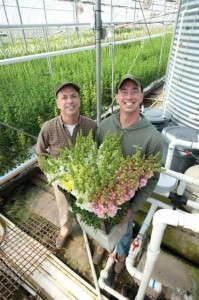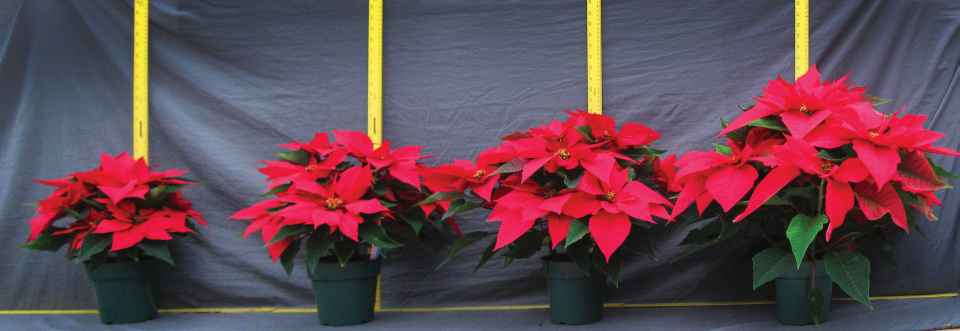Precision Irrigation: How And Why?

Flowers By Bauers & Greenhouses was able to increase the yield and improve the quality of their cut snapdragons by switching over to precision irrigation. Picture courtesy of Edwin Remsberg/University of Maryland.
Water availability and quality are important issues throughout much of the U.S. Although the severe drought in California gets most of the attention, it seems there is always some part of the country that faces drought. In other places, such as Florida and the Chesapeake Bay area, water quality issues are a major concern. These issues affect agriculture, including the greenhouse industry. One of the challenges our industry will need to address is to decrease water use and minimize any negative environmental impacts.
For the last decade, we have been working on ways to help the greenhouse industry reach those goals. We have focused on the use of sensors to provide growers with the information they need to make better irrigation decisions. We have also developed hardware and software that helps growers automate irrigation based on that information. And we are working on ways to help growers make more informed fertilization decisions. Some of that work is described in another article in this issue (see “Automated Fertigation For Greater Control Of Fertilizer”)
Our basic approach is pretty simple: we use soil moisture sensors to measure how wet the substrate is. When the substrate gets too dry, the crop is automatically irrigated. This results in on-demand irrigation: when crops use a lot of water, they automatically get irrigated more frequently.
Implementing this irrigation approach is fairly simple in many greenhouses. If you have an advanced environmental control system, you probably can already integrate soil moisture sensors into this system. The next step would be to monitor substrate water content data to see how your current irrigation practices affect substrate water content. With that information at your fingertips, you can probably see how you could do things differently. And once you are comfortable with the data, you can take the next step and have the environmental controller trigger irrigation automatically, based on substrate water content readings.
For smaller greenhouses, which often have very simple environmental controllers, and for nurseries, we have developed a different solution: stand-alone wireless sensor networks. These sensor networks consist of individual nodes, with up to five sensors plugged into each measuring node. The node has a radio built-in for communication with the base-station computer. Separate control nodes can open and close solenoid valves, based on commands that are sent by the base-station. Growers use the base-station to monitor the data and to set irrigation parameters. The software to do this is accessible through any internet browser, which makes all information accessible online.
Since the nodes are powered by batteries, they can be placed in production areas where power is not available. This system has been designed for maximum flexibility and will be available from Decagon Devices, a company that has collaborated on this project.
As part of our work on this project, we have done trials in university greenhouses and in commercial greenhouses and nurseries. Especially our work with commercial growers has given us many insights into the potential benefits growers can get out of precision irrigation. The following sections provide some of the highlights of what this technology can do for growers.
Provide Growers With Real-Time Information
Sensor networks provide growers with soil moisture and environmental conditions for their own greenhouse or nursery. Since the data can be seen online, access to this information is easy. This provides growers with information they trust and can act upon.
We have learned that most growers make much better irrigation management decisions once they have access to data collected in their own operation. Seeing the impact that your irrigation decisions have on substrate water content makes it easy to improve on standard practices.
Precision Control Of Irrigation
We have shown through our research that we can achieve between a 40 percent and 70 percent reduction in irrigation water applications with soil moisture sensor-based irrigation control. Although reductions vary from operation to operation, because all growers manage irrigation differently, we have consistently seen large reductions in irrigation water use.
For one of our nursery growers, a 50 percent reduction in irrigation saved more than 43 million gallons of water, and $6,500 in pumping costs in 2012. In the central valley of California, where water costs are typically $750/acre foot, the net cost of this 43 million gallons of water would have been at least $100,000, without accounting for additional pumping, plant growth or other economic benefits. In this case, the return on investment for the $48,000 sensor network would have been less than four months.
Impact On Water Availability
For most growers, the cost of water is low compared to other variable costs, such as labor. However, some operations are limited by the capacity of their well or pump, or by the time it takes to irrigate all the crops. Water availability and irrigation time can limit the amount of plants that can be grown. One nursery grower was able to install an additional 30-acre tree production area, simply based on the amount of water he saved elsewhere using sensor-based irrigation.
Increased Yields And Quality
Growers can use these sensors as a tool to refine their growing practices for increases in yield and quality. For example, a snapdragon cut flower grower was able to make more timely irrigation decisions through the use of sensor networks in his greenhouse production. Because these plants were grown in a recycling hydroponics system, water savings were not much of a concern. But better irrigation management increased the yield and quality of snapdragon cut-flowers by 30 percent depending on season and cultivar. This clearly shows that the benefits of precision irrigation go well beyond just water savings .
Risk And Labor Costs Reduction
The automation and control of irrigation in many greenhouses and nurseries can have a large impact not only on water, nutrient use and disease management. But for many larger operations, it is likely to reduce the fixed costs of at least one to two full-time irrigation managers. For many growers, this would amount to between $50,000 and $75,000 per year.
It is unlikely that these jobs would be lost, since lower-skill jobs (opening and closing valves, hand-watering) would be replaced by higher-skill jobs (monitoring and maintenance, data interpretation of computer-controlled irrigation systems). With better information provided by sensor networks, irrigation managers are likely to make much better and more timely irrigation decisions, and translate that knowledge into better nutrient management results (for example by reducing unneeded leaching).
Reductions In Nutrient Leaching
Water moves fertilizer through the soil or substrate, so irrigation management is a key part of nutrient management. Excessive irrigation leaches fertilizer from the substrate. The leaching of fertilizer from the substrate may then require additional fertilizer applications. We found that sensor-based irrigation control can greatly reduce fertilizer leaching, cutting the required fertilizer applications by 50 percent. We have estimated that just in Georgia, this could save ornamental growers about $10 million per year in fertilizer costs.
Fertilizer savings can be achieved regardless of whether water-soluble or controlled-release fertilizer is used. When using water-soluble fertilizer, less irrigation will automatically reduce fertilizer applications. When controlled-release fertilizers are used, better irrigation management will reduce the amount of fertilizer that is leached and thus reduce the need for additional fertilizer applications.
Reduced leaching can also help growers meet environmental regulations. For example, growers in Maryland and Florida need to demonstrate reductions in nutrient use as a key part of complying with state-mandated nutrient management regulations. A reduction in leaching also reduces the runoff from herbicide, fungicide and systemic pesticide applications.

The different size poinsettias were produced by imposing different durations of precisely controlled drought. This is a non-chemical alternative to the use of growth regulators.
An Alternative To Plant Growth Regulators
Plant growth regulators are widely used in the greenhouse industry to control plant size. Research with poinsettias has shown that sensor-controlled irrigation can be used as a non-chemical alternative to the use of PGRs. Sensor-controlled irrigation can be used to expose plants to a controlled water deficit. This can be used to reduce the stem elongation rate when plants get too tall.
Using sensor-controlled irrigation systems, growers can maintain a lower substrate water content for as long as needed to get the amount of growth regulation needed. Additionally, the water deficit effect quickly ends after substrate water content is increased again, in contrast to using PGRs. The use of non-chemical growth regulation can also be used for marketing purposes, since consumer concern over the use of agro-chemicals is steadily increasing.
Disease Management
Sensor-based irrigation decreased disease-related shrinkage in gardenias from 30 percent to virtually zero. On top of that, the production cycle was shortened from 14 to eight months, reducing the required inputs (labor, fertilizer, fungicides, etc.). Combined, this resulted in a 2.5-fold increase in annualized profit, with a payback period of less than one month on the sensor network (approximately $6,000). Although perhaps unusual, this study illustrates the compounded economic benefits of increases in efficiency, yield and disease reduction, as well as increased turnover of production space.
Overall Environmental Benefits
We projected environmental benefits with a variety of scenarios for ornamental growers in the U.S. For example, using a 50 percent industry adoption rate in the ornamental industry alone, a 50 percent reduction in water would save enough water for 400,000 households a year, reduce energy usage equivalent to removing 7,500 cars annually and prevent 620,000 lbs. of nitrogen and 400,000 lbs. of phosphorus from entering the environment. So the benefits of this technology go well beyond individual growers. Society-at-large benefits, as well.
Because of the societal benefits of the technology, it is likely that federal cost-share programs could be used to help pay for the on-farm installation of sensor networks. We already have talked to the National Resources Conservation Service about this and its environmental quality incentives program (EQIP) will likely offer opportunities for matching funds.
The Benefits Continue To Evolve
Perhaps the main thing we have learned over the last decade is that we can never know what to expect. The growers we have worked with have taken this technology and at times used it in ways we never expected. As a result, predicting all possible benefits from the technology is not possible. It will be exciting to see the technology adoption by the industry and to see how this will be used. But one thing has become clear: growers quickly adapt to the technology and find ways to maximize their benefits.
This work was part of a much larger project that included too many people to mention here. But to learn more about what we have done, please visit the project website at www.smart-farms.net. To help growers learn more about wireless sensor networks. The authors have developed an online learning center at Smart-Farms.org. This work has been sponsored by the American Floral Endowment and USDA–NIFA Specialty Crops Research Initiative Award #2009-51181-05768.








